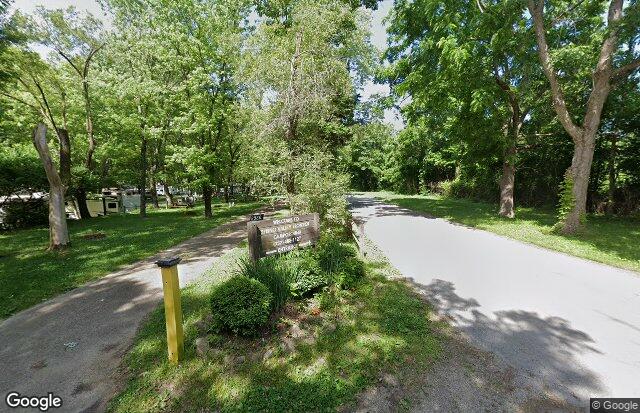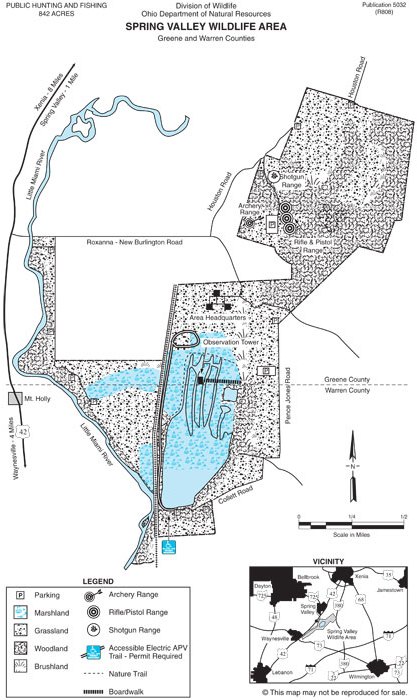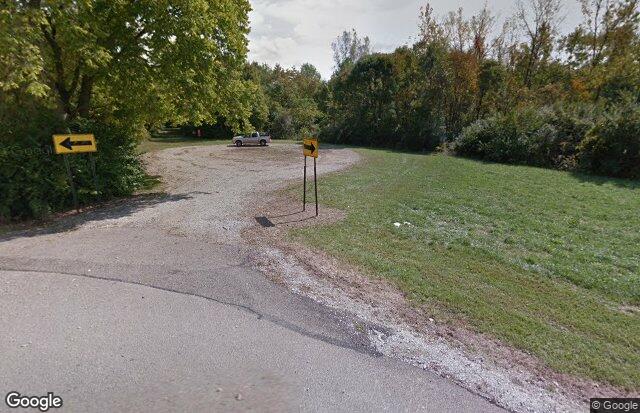
Spring Valley Wildlife Area
Tips for Birding
Spring Valley extends into both Greene and Warren counties and is a great place to visit in March. This location has diverse habitats for early migrant species such as kinglets, creepers, and sparrows. The waterfowl diversity during the spring migration can be great along with some early marsh birds beginning to sing such as Virginia Rails!
Spring Valley Wildlife Area is relatively small (842 acres) but contains a wonderful variety of habitats of interest to the birder. Its bird list features more than 230 species including almost all of the birds commonly seen in southwest Ohio. Of special note is one of the largest and most easily accessed marshes in the area. Other notable habitats include mature hardwoods, brushy hedgerows, croplands, and overgrown fields. The wetlands comprise about 150 acres and are encircled by an easily traversable trail. A boardwalk (reached by taking the unmarked trail at the south end of the upper parking lot) allows excellent access to the marsh without disturbing the delicate ecosystem. The boardwalk ends at an observation tower which provides a panoramic view of the entire area.
An excellent strategy for birding the area is to walk the boardwalk for marsh birds, then hike the 2.5-mile trail which circles the wetland. The canopy that shelters the bike trail to the west of the lake (old railroad right of way) should be checked in spring and fall for migrant passerines, and the brushy areas surrounding the parking lots are excellent for sparrows in season.
To reach Spring Valley from Dayton take OH-48 south to OH-725 (8.5 miles.) Turn left onto OH-725 and drive approximately 10 miles to US-42. Turn right onto US-42. Drive 1.7 miles on US-42 to Roxanna-New Burlington Road. Turn left onto Roxanna-New Burlington Road and follow it to Pence-Jones Road (1.5 miles.) Turn right onto Pence-Jones Road. The upper parking lot is 0.3 miles ahead on the right. The lower parking lot is 0.9 miles farther and is reached by following Pence-Jones Road until and dead ends at Collett Road, then turning right and following Collett Road until it ends at the Wildlife Area.
Open dawn to dusk year-round. Heavily used by hunters in the autumn hunting season.
The north parking lot (unmarked about 0.25 miles south of the intersection of Roxanna-New Burlington and Pence-Jones Road) allows easy access to the marsh and the boardwalk. (An unmarked trail to the boardwalk begins at the south side of this parking lot. The south parking lot is accessed by following Pence-Jones Road to the south, then turning right onto Collett Road which terminates in the Wildlife Area.
Mosquitoes can be horrendous during the spring and summer months and poison ivy is plentiful along the trail that circles the marsh.
Birds of Interest
Winter
Good for dabbling ducks and other water birds until the water freezes. Barred owls are reliable here.
Spring
Excellent for marsh birds including bitterns, Virginia rails, and soras. The canopy over the bike trail and the hardwoods at the south end can be good for neotropical migrants. Shorebirding can be good when water levels offer appropriate habitats.
Summer
Nesting species include prothonotary and yellow-throated warblers, and red-headed woodpeckers. Virginia rails and least bitterns are occasional nesters.
Fall
Good numbers of migrants use the area. Shorebirding can be excellent or nonexistent depending on water levels.
About this Location
If you carefully keep your bird records by county, be sure to use the specific hotspots in this this wildlife area so that the birds will be assigned to the proper county. The north section of the wildlife area is in Greene County. The southern section is in Warren County.
Please note that the boardwalk at the Spring Valley Wildlife Area has been closed. There are no plans to repair and reopen it.
This 842-acre wildlife area is situated in the gently rolling agricultural region of southwest Ohio just east of the Little Miami River, eight miles south of Xenia, and four miles north of Waynesville. The area may be reached by turning east off US-42 onto Roxanna-New Burlington Road.
More than one-third of the area is in cropland and permanent meadow intermixed with brushy fence rows and extensive brushy coverts. Woods cover approximately a third of the area. A 150-acre lake and marsh complex are located on the area’s south edge.
Purchasing of land for this public hunting and fishing area began in 1953. The area includes the old Sinclair Fur Farm lake and marsh which was improved in 1954 to provide the present 80-acre lake. In addition to hunting and fishing, secondary uses, such as gun and archery target shooting and wildlife observation, have become increasingly important.
Cropland is managed to provide a good distribution of wildlife food and cover in conjunction with the permanent meadow and woody cover. More than 100,000 trees and shrubs have been planted to provide permanent wildlife cover.
Features
Restrooms on site
Content from Official Website, Tyler Ficker, Ohio Ornithological Society Southwest Regional Director, and Ohio Ornithological Society


